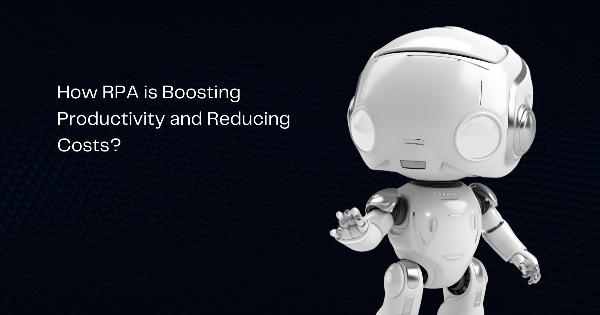How RPA is Boosting Productivity and Reducing Costs?

Strong 8k brings an ultra-HD IPTV experience to your living room and your pocket.
Robotic Process Automation (RPA) is changing the way businesses operate. With the global RPA market size valued at USD 2,942.7 million in 2023 and expected to grow at a compound annual growth rate (CAGR) of 39.9% from 2023 to 2030, it's clear that businesses are recognizing the immense value of automation
The implementation of RPA Development services allows businesses to automate repetitive tasks, freeing up human resources for more valuable work.This results in a substantial improvement in effectiveness and output. Moreover, businesses can cut operational costs, making RPA a critical tool in today’s competitive landscape.
What is RPA?
Robotic Process Automation refers to using software robots to carry out repetitive tasks. These automated machines can imitate human activities like clicking, writing on a keyboard, and retrieving information. Unlike traditional automation, RPA doesn’t require deep system integration. This makes it a faster and more affordable option for businesses of all sizes.
Many organizations are now integrating RPA into their systems.The technology can be applied in various sectors, including healthcare, manufacturing, retail, and finance. RPA can manage data, handle customer requests, and automate routine back-office tasks. The best part is it doesn’t need breaks. Robots work tirelessly 24/7 without errors.
Why Businesses Turn to RPA?
One of the main reasons businesses adopt RPA is the promise of better productivity. Since RPA can work faster than humans, tasks that used to take days can now be completed in hours or even minutes. Businesses save time, which leads to better resource allocation. Staff members can shift focus to tasks that demand human intelligence and creativity.
Cost reduction is another reason for its popularity. Since RPA handles mundane tasks, there is less need to hire additional staff. Lower workforce costs directly contribute to higher profitability. RPA helps reduce operational expenses by minimizing errors that lead to costly rework or fines.
How RPA Boosts Productivity?
RPA’s ability to work around the clock is one of its main advantages. Businesses no longer have to rely on human workers to complete tasks within work hours. Robots can run scripts and process data without fatigue or breaks. This boosts productivity, allowing businesses to meet customer demands faster.
Imagine a retail company during the holiday season. Traditionally, it would hire temporary staff to handle the surge in orders. With RPA, software robots can handle order processing, invoicing, and tracking without needing extra manpower. This allows the business to serve customers faster, leading to better customer satisfaction.
Another key productivity boost comes from RPA’s accuracy. Human errors, like data entry mistakes, can slow down processes and require rework. RPA eliminates such errors, ensuring tasks are done correctly the first time. This reduces downtime and keeps operations running smoothly.
Reducing Operational Costs with RPA
RPA is also a powerful tool for cutting costs. Since robots handle repetitive work, businesses don’t need to rely on humans for these tasks. By automating processes, companies can minimize staffing costs. The result is leaner operations that are cost-efficient.
Besides labor costs, RPA helps businesses save in other areas too. For example, errors in data entry or processing often lead to delays or penalties. RPA can eliminate these mistakes, saving businesses from fines or rework. This not only reduces costs but also increases reliability, which is crucial for maintaining customer trust.
Another area where RPA shines is its ability to scale. As businesses grow, their operational needs increase. Hiring more people is the only way to manage the workload without automation. However with RPA, businesses can scale up their operations without hiring new staff. This leads to even more savings as the company grows.
Applications of RPA Across Different Industries
RPA is highly adaptable, making it suitable for many industries. Whether it’s finance, healthcare, or manufacturing, the potential for automation is immense. Below are examples of how various sectors benefit from RPA.
1. Finance and Banking
Banks handle thousands of transactions every day. They must also comply with strict regulations. Errors in data processing can lead to compliance issues. RPA helps banks process transactions accurately and swiftly. It also ensures that compliance reports are generated on time. This reduces the risk of fines or penalties and ensures smooth operations.
2. Healthcare
The healthcare industry deals with a lot of paperwork. From patient records to insurance claims, managing this data can be a nightmare. RPA simplifies data entry, file management, and claims processing. It ensures that patient records are updated in real-time, improving service delivery.
3. Manufacturing
In manufacturing, RPA can automate routine tasks like inventory management and order processing. It ensures that orders are processed on time, reducing downtime in production. By automating supply chain processes, manufacturers can focus on producing high-quality products without delays.
4. Retail
Retail businesses often deal with fluctuating demand. During busy season, they struggle with handling large numbers of orders. Robotic Process Automation can automatically process orders, respond to customer questions, and monitor stock levels. This ensures that customers get their orders on time without the business needing to hire additional staff.
Challenges and Limitations of RPA
While RPA offers several advantages, it also has its challenges. Implementing RPA can sometimes be a tricky process, especially in industries with complex workflows. The initial setup might be costly and time-consuming, requiring businesses to adapt their existing systems.
RPA also isn’t the best option for every task. While it’s perfect for repetitive tasks, it doesn’t handle decision-making well. Processes that require judgment or complex problem-solving are still best handled by humans. Businesses need to assess which tasks are suitable for RPA before implementation.
Another challenge is maintaining RPA systems. As businesses grow or change, their workflows may evolve. If an RPA system isn’t updated accordingly, it may become obsolete or even counterproductive. Ensuring regular updates and maintenance is necessary to keep the system running smoothly.
Steps to Implement RPA in Your Business
Implementing RPA isn’t as simple as turning on a switch. It requires careful planning and execution. Below are steps businesses should follow to ensure successful RPA implementation.
1. Identify Processes to Automate
Not every task is suitable for automation. The first step in RPA implementation is identifying tasks that are repetitive and rule-based. These tasks should also be high in volume. Automating small, infrequent tasks won’t have much of an impact. Instead, focus on those that consume the most time and resources.
2. Assess the Cost and Benefits
Before investing in RPA, assess the costs involved in implementation. Consider both the initial setup costs and the ongoing maintenance. Compare this with the potential savings in labor and error reduction. This will give you a clear picture of whether RPA is worth the investment.
3. Choose the Right RPA Solution
Not all RPA software is created equal. Businesses need to choose the right RPA tools for their needs. Some solutions are tailored for specific industries, while others offer general functionality. It's crucial to pick a solution that seamlessly fits with your current systems.
4. Test and Optimize
Once RPA is implemented, it’s essential to test it thoroughly. Ensure that the automation performs as expected and doesn’t disrupt other workflows. Be prepared to tweak the system to optimize its performance.
5. Train Your Workforce
RPA won’t replace your entire workforce.Employees will need to learn how to collaborate with robotic process automation (RPA) systems. By understanding how the system works, they can monitor and manage automated processes effectively. Proper training also ensures that employees can handle any issues that arise.
The Future of RPA
The future of RPA is bright. Improvements in artificial intelligence and machine learning are making robotic process automation (RPA) more intelligent. Shortly, RPA systems may handle even more complex tasks. Businesses can automate decision-making and predictive analysis, leading to even greater productivity gains.
Robotic Process Automation (RPA) will not replace human workers, but rather work together with them to build a more effective workforce. The combination of human creativity and robotic efficiency will lead to new opportunities for businesses to grow.
As RPA continues to evolve, businesses will need to stay updated with the latest developments. Regular updates and system improvements will be key to maintaining a competitive edge in the market.
Conclusion
RPA is not just a buzzword; it’s transforming industries by boosting productivity and cutting costs. Businesses across sectors are adopting RPA Development services to automate repetitive tasks and free up resources. Whether it’s processing data, handling customer requests, or managing inventory, RPA can handle it all.
For businesses looking to stay competitive, it’s time to embrace automation. By working with experts, companies can integrate RPA into their systems without disruption. If you are looking for experts to guide you through this transformation, it’s time to hire RPA Developers to ensure a smooth transition.
RPA offers endless potential for improving business operations. By using it wisely, businesses can increase their productivity and profitability without compromising on quality.
Note: IndiBlogHub features both user-submitted and editorial content. We do not verify third-party contributions. Read our Disclaimer and Privacy Policyfor details.


